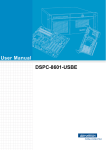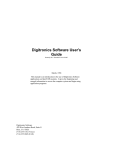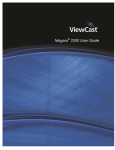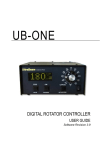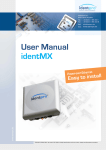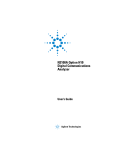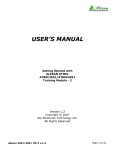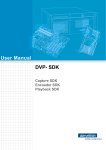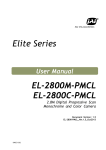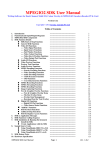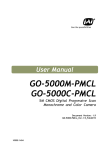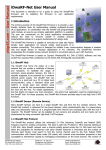Download DVP-1412
Transcript
DVP-1412
1 Channel MPEG 1/2/4 Digital
Video Encoder Module with
128-byte EEPROM, USB 2.0
interface
User Manual
Copyright Notice
This document is copyrighted, 2005, by Advantech Co., Ltd. All rights are reserved.
Advantech Co., Ltd. reserves the right to make improvements to the products described in
this manual at any time without notice.
No part of this manual may be reproduced, copied, translated or transmitted in any form or by
any means without the prior written permission of Advantech Co., Ltd. Information provided in
this manual is intended to be accurate and reliable. However, Advantech Co., Ltd. assumes
no responsibility for its use, nor for any infringements upon the rights of third parties which
may result from its use.
Acknowledgements
IBM and PC are trademarks of International Business Machines Corporation. MS-DOS,
Windows, Microsoft Visual C++ and Visual BASIC are trade-marks of Microsoft Corporation.
Intel and Pentium are trademarks of Intel Corporation. DivX® is a registered trademark of
DivX Networks, Inc. All other product names or trademarks are the properties of their
respective owners.
On-line Technical Support
For technical support and service, please visit our support website at:
http://www.advantech.com/support
1nd. Edition
Printed in Taiwan January 2005
I
0.0.1 A Message to the Customer
Advantech customer services
Each and every Advantech product is built to the most exacting specifications to ensure
reliable performance in the harsh and demanding conditions typical of industrial environments.
Whether your new Advantech equipment is destined for the laboratory or the factory floor, you
can be assured that your product will provide the reliability and ease of operation for which
the name Advantech has come to be known. Your satisfaction is our primary concern. Here is
a guide to Advantech’s customer services. To ensure you get the full benefit of our services,
please follow the instructions below carefully.
Technical support
We want you to get the maximum performance from your products. So if you run into
technical difficulties, we are here to help. For the most frequently asked questions, you can
easily find answers in your product documentation. These answers are normally a lot more
detailed than the ones we can give over the phone.
So please consult this manual first. If you still cannot find the answer, gather all the
information or questions that apply to your problem, and with the product close at hand, call
your dealer. Our dealers are well trained and ready to give you the support you need to get
the most from your Advantech products. In fact, most problems reported are minor and are
able to be easily solved over the phone.
In addition, free technical support is available from Advantech engineers every business day.
We are always ready to give advice on application requirements or specific information on the
installation and operation of any of our products.
II
Table 0.1 DVP1412 Specification
Video / Audio
Host Communication
Hardware
Input connectors
Video Standard
Resolution*
Frame Rate
Video Encoding
Data Output format
Audio output
Host interface
Max. module
Driver and SDK
Demo program
EEPROM
Dimensions (WxL)
Power consumption
Temperature
BNC or pin-header
NTSC / PAL
Full D1 / VGA / QVGA / CIF / QCIF
Up to 30fps (NTSC) / 25pfs (PAL)
MPEG-1, MPEG-2, MPEG-4
MPEG-4 Simple Profile @ L3 plus B-picture support
MPEG-2 MP @ ML
MPEG-1
Stereo input, PCM format data stream output
High-speed USB 2.0
Up to 8 modules in one PC system, set by DIP switch
Supports Microsoft Windows® 2000 / XP
Complete demo program with C++ source code for reference
128 bytes, includes SDK for programming
70mm x 38 mm
+5V DC input by USB bus with standard 500mA supply
0 ~ 60 ºC (32 ~ 140 ºF; Operating)
-20 ~ 70 ºC (-4 ~ 158 ºF; Non-Operating)
Table 0.2 Video Resolution Index
Abbreviate
D1 (DVD Quality)
VGA
QVGA
CIF (VCD Quality)
QCIF
Technical Terms / Video System
Full resolution
Video Graphics Array
Quarter VGA
Common Intermediate Format
Quarter CIF
III
NTSC
720x480
PAL
720x576
640x480
320x240
352x240
352x288
176x120
176x144
0.0.2 Product warranty
Advantech warrants to you, the original purchaser, that each of its products will be free from
defects in materials and workmanship for two years from the date of purchase.
This warranty does not apply to any products which have been repaired or altered by persons
other than repair personnel authorized by Advantech, or which have been subject to misuse,
abuse, accident or improper installation. Advantech assumes no liability under the terms of
this warranty as a consequence of such events.
If an Advantech product is defective, it will be repaired or replaced at no charge during the
warranty period. For out-of-warranty repairs, you will be billed according to the cost of
replacement materials, service time and freight. Please consult your dealer for more details.
If you think you have a defective product, follow these steps:
Step 1. Collect all the information about the problem encountered. (For example, type of PC,
CPU speed, Advantech products used, other hardware and software used, etc.) Note
anything abnormal and list any on-screen messages you get when the problem occurs.
Step 2. Call your dealer and describe the problem. Please have your manual, product, and
any helpful information readily available.
Step 3. If your product is diagnosed as defective, obtain an RMA (return material
authorization) number from your dealer. This allows us to process your return more quickly.
Step 4. Carefully pack the defective product, a fully-completed Repair and Replacement
Order Card and a photocopy proof of purchase date (such as your sales receipt) in a
shippable container. A product returned without proof of the purchase date is not eligible for
warranty service.
Step 5. Write the RMA number visibly on the outside of the package and ship it prepaid to
your dealer.
IV
0.0.3 Initial Inspection
Before you begin installing your motherboard, please make sure that the following materials
have been shipped:
• 1 * DVP-1412 video encoder card
• 1 * CD with driver utility , SDK and user manual (in PDF format)
• 1 * internal USB cable
If any of these items are missing or damaged, contact your distributor or sales representative
immediately.
We have carefully inspected theDVP-1412 mechanically and electrically before shipment. It
should be free of marks and scratches and in perfect working order upon receipt.
As you unpack the DVP-1412, check it for signs of shipping damage. (For example, damaged
box, scratches, dents, etc.) If it is damaged or it fails to meet the specifications, notify our
service department or your local sales representative immediately. Also notify the carrier.
Retain the shipping carton and packing material for inspection by the carrier. After inspection,
we will make arrangements to repair or replace the unit.
0.0.4 Release Note
Date
January 2005
Revision
1st. Edition
Change
Initial Release & support MPEG4 only
V
Table of Content
CHAPTER 1 GENERAL INFORMATION ........................................................................................1
1.1 HARDWARE REQUIREMENT ............................................................................................................2
1.2 SOFTWARE REQUIREMENT ..............................................................................................................2
1.3 BLOCK DIAGRAM ...........................................................................................................................2
Figure 1.1 DVP 1412 block diagram ............................................................................................................ 2
1.4 DIMENSION .....................................................................................................................................3
Figure 1.2 DVP-1412 Dimension Diagram .................................................................................................. 3
1.5 JUMPER/CONNECTOR LOCATION .....................................................................................................3
Figure 1.3 DVP-1412 Jumper & Connector location.................................................................................... 3
1.6 CHANNEL/MODULE ID SELECTION SWITCH ....................................................................................4
Table 1.1 Channel/Module ID selection table............................................................................................... 4
1.7 PIN-DEFINITION DESCRIPTION .........................................................................................................4
1.7.1 Internal video & audio input ...................................................................................................4
Table 1.2 Internal Video & Audio input ....................................................................................................... 4
1.7.2 USB to host board interface ....................................................................................................4
Table 1.3 USB 2.0 interface.......................................................................................................................... 4
1.8 SOFTWARE / DRIVER INSTALLATION ..............................................................................................4
1.9 HARDWARE INSTALLATION ............................................................................................................8
1.10 MPEG 4 CODEC INSTALLATION ....................................................................................................8
CHAPTER 2 FUNCTIONS LIBRARY................................................................................................9
SUMMARY ...........................................................................................................................................10
FUNCTIONS REFERENCE ......................................................................................................................11
Struct ..............................................................................................................................................11
METHOD..............................................................................................................................................12
DVP1412_CreateSDKInstence.......................................................................................................12
DVP1412_GetNumberOfDevices ...................................................................................................13
DVP1412_InitSDK .........................................................................................................................14
DVP1412_CloseSDK......................................................................................................................15
DVP1412_Start...............................................................................................................................16
DVP1412_Stop ...............................................................................................................................17
DVP1412_GetCapState ..................................................................................................................18
DVP1412_SetRecord ......................................................................................................................19
DVP1412_IsVideoPresent ..............................................................................................................20
DVP1412_GetStatistics ..................................................................................................................21
DVP1412_GetCompressMode........................................................................................................22
DVP1412_SetCompressMode ........................................................................................................23
DVP1412_GetVideoStandard.........................................................................................................24
DVP1412_SetVideoStandard..........................................................................................................25
DVP1412_GetResolution................................................................................................................26
DVP1412_SetResolution ................................................................................................................27
DVP1412_GetFrameRate...............................................................................................................28
DVP1412_SetFrameRate................................................................................................................29
DVP1412_GetBitRate.....................................................................................................................30
DVP1412_SetBitRate .....................................................................................................................31
DVP1412_GetSequenceMode ........................................................................................................32
DVP1412_SetSequenceMode .........................................................................................................33
DVP1412_GetMpeg4GOPSize .......................................................................................................34
DVP1412_ SetMpeg4GOPSize.......................................................................................................35
DVP1412_GetBrightness................................................................................................................36
DVP1412_SetBrightness ................................................................................................................37
DVP1412_GetContrast...................................................................................................................38
DVP1412_SetContrast....................................................................................................................39
DVP1412_GetHue..........................................................................................................................40
DVP1412_SetHue...........................................................................................................................41
DVP1412_GetSaturation................................................................................................................42
DVP1412_SetSaturation.................................................................................................................43
DVP1412_ReadEE .........................................................................................................................44
DVP1412_WriteEE.........................................................................................................................45
2
DVP-1412 User Manual
CHAPTER
1
General Information
1
DVP-1412 User Manual
Chapter 1 General Information
Designed for embedded application or upgrade with digital video function market, the DVP1412 is a very compact-size, hardware MPEG4 encode embedded module which is very easy
integrate with most of equipment such as Panel PC, Industrial Embedded controller. It can
accept standard composite video input through BNC or pin-header. The DVP-1412 provides
complete SDK and driver on MS-Windows 2000/XP/XP embedded environment.
By using a standard high-speed USB 2.0 interface, the DVP-1412 is very easy to work with
most of Single Board Computer or PC system. Due to the hardware MPEG 1/2/4 video
encode engine, the DVP-1412 can reduce the main CPU’s loading and programmer’s coding
time. The DVP-1412 is also supporting up to 30/25 fps (NTSC/PAL) at D1 resolution. By the
dynamically adjustable bit rate and frame rate to accommodate variable bandwidths, DVP1412 can optimize the quality and bandwidth at the best. Through on board’s 128 Bytes
EEPROM space, programmer can place the protection code or system parameter on it via our
SDK. The DVP-1412 is a ideal embedded digital video solution for most of applications such
as DVR (Digital Video Recorder), PVR (Personal Video Recorder), Video phone or others
embedded with video function equipments.. For extension issue, DVP-1412 can be up to 8
modules in one PC system by setting DIP switch.. Please reference the jumper / connector
location for the location of module number.
1.1 Hardware Requirement
•
•
•
•
•
Intel Pentium 1.0G Hz or above (The CPU speed is depends on the video frame rate,
channels and resolution)
128MB RAM or above
USB 2.0 host port
CD-ROM
Hard disk with 128MB free space
1.2 Software Requirement
•
Microsoft Windows 2000/XP with DirectX 8.1 or above
1.3 Block Diagram
Figure 1.1 DVP 1412 block diagram
2
DVP-1412 User Manual
1.4 Dimension
Figure 1.2 DVP-1412 Dimension Diagram
1.5 Jumper/Connector Location
Audio Input
USB 2.0
Channel ID selection switch
Video Input
(BNC)
J2: Internal Video & Audio connector
Figure 1.3 DVP-1412 Jumper & Connector location
3
DVP-1412 User Manual
1.6 Channel/Module ID selection switch
The channel switch is a DIP switch which can set the channel/module ID before installation.
Table 1.1 Channel/Module ID selection table
Channel
01
02
03
04
05
06
07
08
SW1
Off
On
Off
On
Off
On
Off
On
SW2
Off
Off
On
On
Off
Off
On
On
SW3
Off
Off
Off
Off
On
On
On
On
SW4 (reserved)
Off (default)
Off (default)
Off (default)
Off (default)
Off (default)
Off (default)
Off (default)
Off (default)
1.7 Pin-definition description
1.7.1 Internal video & audio input
The J2 video & audio input is a internal input which parallel with the BNC & audio connectors
for board camera applications.
Table 1.2 Internal Video & Audio input
Pin
1
2
Signal
Video in
Audio in - Left channel
Pin
3
4
Signal
Audio in - Right channel
GND
1.7.2 USB to host board interface
The internal USB connector is a USB 2.0 device interface which connected to host controller
such as PCM series biscuit boards or PICMG CPU cards.
Table 1.3 USB 2.0 interface
Pin
1
2
Signal
+5V
Data (-)
Pin
3
4
Signal
Data (+)
GND
1.8 Software / Driver Installation
Before you begin
To facilitate the installation of the enhanced display device drivers and utility software, you
should read the instructions in this chapter carefully before you attempt installation. The
drivers for the DVP-1412 board are located on the software installation CD. Before you begin,
4
DVP-1412 User Manual
it is important to note that most display drivers need to have the relevant software application
already installed in the system prior to installing the enhanced display drivers. In addition,
many of the installation procedures assume that you are familiar with both the relevant
software applications and operating system commands. Review the relevant operating
system commands and the pertinent sections of your application software user manual before
performing the installation.
Installation Step
1. Insert the driver CD into your system's CD-ROM drive. Go to the SDK_Driver folder of
DVP-1412 CD. Move the mouse cursor over the "Setup.exe" & double-click it. Then, a
message pops up telling you to start the installation.
2. Click "Next" when you see the following message.
5
DVP-1412 User Manual
3. Please read the following license agreement and select "Yes" or "No" to next status.
4. Please choose the destination folder and Click "Next".
6
DVP-1412 User Manual
5. When the following message appears, give a name to the program folder, then click “Next”
to install.
6. Click "Next" when you see the following message.
7
DVP-1412 User Manual
7. When the following message appears, click "Finish" to complete the installation and restart
Windows.
1.9 Hardware Installation
1. Turn off your computer and unplug the power cord.
2. Remove the cover of your computer.
3. Touch the metal part on the surface of your computer to neutralize the static electricity
that might be on your body.
4. Setting the channel/module ID switch (SW1) while you want.
5. Place the DVP-1412 into chassis and using screws to fix it.
6. Plug the USB cable into DVP-1412 USB connector and host port with 500mA capability.
7. Connect appropriate accessories (Video cable to camera. if necessary) to the DVP-1412
module.
8. Replace the cover of your computer chassis.
9. Plug in the power cord and turn on the computer.
10. Computer will detect the new hardware & manually set the driver destination folder to the
same path of step 1.8 Software / Driver Installation.
For example, “C:\Program Files\ADVANTECH\DVP1412”
Note:
Keep the anti-static bag for future use. You might need the original bag to
store the card if you have to remove the card from the PC or transport it
elsewhere.
1.10 MPEG 4 Codec Installation
For review the video encoded by DVP-1412, users need MPEG4 codex installation first. Free
MPEG4 codex can be download at http://www.divx.com
Or users can install the DivX codex from the DVP-1412 utility disc. Please use the DivX codex
of version 5.0 or above.
8
DVP-1412 User Manual
CHAPTER
2
Functions Library
9
DVP-1412 User Manual
Chapter 2 Functions Library
Summary
SDK Initialize and close
DVP1412_CreateSDKInstence
DVP1412_GetNoOfDevices
DVP1412_InitSDK
DVP1412_CloseSDK
Capture control
DVP1412_Start
DVP1412_Stop
DVP1412_GetCapState
DVP1412_SetRecord
DVP1412_IsVideoPresent
DVP1412_GetStatistics
Capture setting
DVP1412_GetCompressMode
DVP1412_SetCompressMode
DVP1412_GetVideoStandard
DVP1412_SetVideoStandard
DVP1412_GetResolution
DVP1412_SetResolution
DVP1412_GetFrameRate
DVP1412_SetFrameRate
DVP1412_GetBitRate
DVP1412_SetBitRate
DVP1412_GetSequenceMode
DVP1412_SetSequenceMode
DVP1412_GetMpeg4GOPSize
DVP1412_SetMpeg4GOPSize
Sensor Control
DVP1412_GetBrightness
DVP1412_SetBrightness
DVP1412_GetContrast
DVP1412_SetContrast
DVP1412_GetHue
DVP1412_SetHue
DVP1412_GetSaturation
DVP1412_SetSaturation
EE Controller
DVP1412_ReadEE
DVP1412_WriteEE
Note:
[DVP-1412 Sample program] After installation, DVP-1412 sample program
is in the destination folder in driver installation step as file name
"dvp1412exe.zip". User can un-zip the file & take those sample program
files as reference as programming or developing.
10
DVP-1412 User Manual
Functions Reference
Struct
DeviceSettingStruct
typedef struct{
VideoStandard videoStandard;
CompressMode compressMode;
MPEG4Mode mpeg4Mode;
SequenceMode sequenceMode;
Resolution resolution;
FrameRate frameRate;
int bitRate;
int gopSize;
} DeviceSettingStruct;
Parameters
videoStandard:
compressMode:
mpeg4Mode:
sequenceMode:
resolution:
frameRate:
bitRate:
gopSize:
Current video standard setting.
Current compress mode setting.
Current mpeg4 mode setting.
Current sequence mode setting.
Current resolution setting.
Current frame rate setting.
Current bit rate setting.
Current gop size setting.
Description
A stucrt stores current capture setting.
DeviceInfoStruct
typedef struct{
DeviceSettingStruct setting;
CapState capState;
} DeviceInfoStruct;
Parameters
setting:
capState:
Struct of current capture setting..
Current capture state.
Description
A stucrt stores all current capture information.
StatisticInfo
typedef struct{
unsigned __int64 ByteCount;
unsigned FrameCount;
} StatisticInfo;
Parameters
ByteCount: Current byte count.
FrameCount: Current frame count.
Description
A stucrt stores current statistic setting.
11
DVP-1412 User Manual
Method
DVP1412_CreateSDKInstence
Syntax
int DVP1412_CreateSDKInstence(void **pp)
Parameters
pp: A pointer to the SDK.
Return Value
SUCCEEDED:
PARAMERROR:
SDKINITFAILED:
Function succeeded.
Parameter error.
Failed to initialize SDK.
Description
This function creates SDK instance.
12
DVP-1412 User Manual
DVP1412_GetNumberOfDevices
Syntax
int DVP1412_GetNoOfDevices(void)
Parameters
None
Return Value
Number of DVP1412 digital video encoder module
Description
This function gets number of DVP1412 module in the system. At most 8 channels are
available in a DVP1412 integrated system.
13
DVP-1412 User Manual
DVP1412_InitSDK
Syntax
int DVP1412_InitSDK(int NoOfDevs, int* IDList)
Parameters
NoOfDevs: Number of devices.
IDs: An array pointer stores all board IDs. Negative value indentifys inactive channel.
Return Value
SUCCEEDED:
FAILED:
BOARDIDERROR:
NODEVICES:
CHECKKEYERROR:
Function succeeded.
Function failed.
Failed to get board ID or duplicate board ID.
No devices found.
Failed to check hardware key.
Description
This function initializes all DVP1412 modules in the system and gets all board IDs. After
initializing each module, the capture status would be set as “STOPPED”.
See Also
DVP1412_GetNoOfDevices
DVP1412_GetCapState
DVP1412_CloseSDK
14
DVP-1412 User Manual
DVP1412_CloseSDK
Syntax
int DVP1412_CloseSDK(void)
Parameters
None
Return Value
SUCCEEDED:
PARAMERROR:
SDKINITFAILED:
Function succeeded.
Parameter error.
SDK not initialized.
Description
This function cleans all instances of capture devices and closes up the SDK.
See Also
DVP1412_InitSDK
15
DVP-1412 User Manual
DVP1412_Start
Syntax
int DVP1412_Start(int BoardID, BOOL toPreview, BOOL toRecord, BOOL doAudio, HWND
hwndPreview)
Parameters
BoardID:
Specifies the board ID number(0~7).
toPreview:
Set current capture board to preview video.
toRecord:
Set current capture board to record video.
doAudio:
Set current capture board to do audio.
hwndPreview:A windows handle for display area.
Return Value
SUCCEEDED:
FAILED:
BOARDIDERROR:
SDKINITFAILED:
FILTERERROR:
Function succeeded.
Function failed.
Invalid board ID.
SDK not initialized.
Filter not initialized.
Description
This function starts video capturing on a specified capture board. The capture state would
be set as “PREVIEW”, “RECORDING”, “PREVIEWandRECORDING” after a successful
start. A DivX decoder filter must be installed to perform video previewing.
See Also
DVP1412_Stop
DVP1412_GetCapState
16
DVP-1412 User Manual
DVP1412_Stop
Syntax
int DVP1412_Stop(int BoardID)
Parameters
BoardID:
Specifies the board ID number(0~7).
Return Value
SUCCEEDED:
FAILED:
BOARDIDERROR:
SDKINITFAILED:
Function succeeded.
Function failed.
Invalid board ID.
SDK not initialized.
Description
This function stops video capturing on a specified capture board. The capture state would
be set as “STOPPED” after a successful stop.
See Also
DVP1412_Start
DVP1412_GetCapState
17
DVP-1412 User Manual
DVP1412_GetCapState
Syntax
int DVP1412_GetCapState(int BoardID)
Parameters
BoardID:
Specifies the board ID number(0~7).
Return Value
BOARDIDERROR:
SDKINITFAILED:
Invalid board ID.
SDK not initialized.
Description
This function gets capture state of a specified capture board.
STOPPED
= 0,
PREVIEW
= 1,
RECORDING
= 2,
PREVIEWandRECORDING
= 3,
UNINITIALIZED
= -1,
UNKNOWNSTATE
= -2
See Also
DVP1412_InitSDK
DVP1412_Start
DVP1412_Stop
18
DVP-1412 User Manual
DVP1412_SetRecord
Syntax
int DVP1412_SetRecord(int BoardID, char Filename[256])
Parameters
BoardID:
Specifies the board ID number(0~7).
Filename:
Specifies recording file name.
Return Value
SUCCEEDED:
FAILED:
BOARDIDERROR:
SDKINITFAILED:
Function succeeded.
Function failed.
Invalid board ID.
SDK not initialized.
Description
This function sets recording file name of a specified capture board. File name must be
assigned before start recording.
See Also
DVP1412_Start
19
DVP-1412 User Manual
DVP1412_IsVideoPresent
Syntax
Int DVP1412_IsVideoPresent (int BoardID, BOOL * VideoPresent)
Parameters
BoardID:
VideoPresent:
Return Value
SUCCEEDED:
FAILED:
BOARDIDERROR:
SDKINITFAILED:
Specifies the board ID number(0~7).
A pointer to get if video signal is present.
Function succeeded.
Function failed.
Invalid board ID.
SDK not initialized.
Description
This function check if video signal is present in the input jet of specified board.
20
DVP-1412 User Manual
DVP1412_GetStatistics
GetStatistics(int BoardID, StatisticInfo *statistic)
Syntax
int DVP1412_GetStatistics (int BoardID, StatisticInfo* statistic)
Parameters
BoardID:
Specifies the board ID number(0~7).
statistic:
A pointer to current video statistic.
Return Value
SUCCEEDED:
FAILED:
BOARDIDERROR:
PARAMERROR:
SDKINITFAILED:
Function succeeded.
Function failed.
Invalid board ID.
Invalid parameter.
SDK not initialized.
Description
This function gets video statistic information(current frame count, current bit count) of a
specified capture board.
See Also
StatisticInfo
21
DVP-1412 User Manual
DVP1412_GetCompressMode
Syntax
int DVP1412_GetVideoFormat(int BoardID, CompressMode *compressmode, MPEG4Mode
* mpeg4mode)
Parameters
BoardID:
Specifies the board ID number(0~7).
Compressmode: This version is for Mpeg4 only.
typedef enum tagCompressMode
{
Mpeg4
= 0,
Mpeg2
= 1,
Mpeg1
= 2,
} CompressMode;
mpeg4mode: A pointer to get mpeg4 encoding mode.
typedef enum tagMPEG4Mode
{
None
= 0,
Divx
= 1,
Microsoft
= 2,
} MPEG4Mode;
Return Value
SUCCEEDED:
BOARDIDERROR:
PARAMERROR:
SDKINITFAILED:
Function succeeded.
Invalid board ID.
Invalid parameter.
SDK not initialized.
Description
This function gets mpeg4 encoding mode of a specified capture board.
See Also
DVP1412_SetCompressMode
22
DVP-1412 User Manual
DVP1412_SetCompressMode
Syntax
int DVP1412_SetVideoFormat(int BoardID, CompressMode *compressmode, MPEG4Mode
mpeg4mode)
Parameters
BoardID:
Specifies the board ID number(0~7).
Compressmode: This version is for Mpeg4 only.
typedef enum tagCompressMode
{
Mpeg4
= 0,
Mpeg2
= 1,
Mpeg1
= 2,
} CompressMode;
mpeg4mode: Mpeg4 encoding mode.
typedef enum tagMPEG4Mode
{
None
= 0,
Divx
= 1,
Microsoft
= 2,
} MPEG4Mode;
Return Value
SUCCEEDED:
FAILED:
BOARDIDERROR:
PARAMERROR:
SDKINITFAILED:
Function succeeded.
Function failed.
Invalid board ID.
Invalid parameter.
SDK not initialized.
Description
This function sets mpeg4 encoding mode of a specified capture board. This function should
be called before “DVP1412_Start”.
See Also
DVP1412_GetCompressMode
23
DVP-1412 User Manual
DVP1412_GetVideoStandard
Syntax
int DVP1412_GetVideoStandard(int BoardID, VideoStandard* standard)
Parameters
BoardID:
Specifies the board ID number(0~7).
standard:
A pointer to get video standard.
typedef enum tagVideoStandard
{
NTSC_M
= 0,
NTSC_M_J
= 1,
PAL_B
= 2,
PAL_M
= 3,
PAL_N
= 4,
} VideoStandard;
Return Value
SUCCEEDED:
BOARDIDERROR:
PARAMERROR:
SDKINITFAILED:
Function succeeded.
Invalid board ID.
Invalid parameter.
SDK not initialized.
Description
This function gets video standard of a specified capture board.
See Also
DVP1412_SetVideoStandard
24
DVP-1412 User Manual
DVP1412_SetVideoStandard
Syntax
int DVP1412_SetVideoStandard(int BoardID, VideoStandard standard)
Parameters
BoardID:
Specifies the board ID number(0~7).
standard:
Video standard.
typedef enum tagVideoStandard
{
NTSC_M
= 0,
NTSC_M_J
= 1,
PAL_B
= 2,
PAL_M
= 3,
PAL_N
= 4,
} VideoStandard;
Return Value
SUCCEEDED:
BOARDIDERROR:
PARAMERROR:
SDKINITFAILED:
Function succeeded.
Invalid board ID.
Invalid parameter.
SDK not initialized.
Description
This function sets video standard of a specified capture board.
See Also
DVP1412_GetVideoStandard
25
DVP-1412 User Manual
DVP1412_GetResolution
Syntax
int DVP1412_GetResolution(int BoardID, Resolution *Size)
Parameters
BoardID:
Specifies the board ID number(0~7).
Size: A pointer to get video resolution.
typedef enum tagResolution
{
NTSC720480 = 0,
NTSC640480 = 1,
NTSC320240 = 2,
NTSC176144 = 3,
PAL720576
= 4,
PAL640480
= 5,
PAL352288
= 6,
PAL176144
= 7,
} Resolution;
Return Value
SUCCEEDED:
BOARDIDERROR:
PARAMERROR:
SDKINITFAILED:
Function succeeded.
Invalid board ID.
Invalid parameter.
SDK not initialized.
Description
This function gets video resolution of a specified capture board.
See Also
DVP1412_SetResolution
26
DVP-1412 User Manual
DVP1412_SetResolution
Syntax
int DVP1412_SetResolution(int BoardID, Resolution Size)
Parameters
BoardID:
Specifies the board ID number(0~7).
Size: Video resolution.
typedef enum tagResolution
{
NTSC720480 = 0,
NTSC640480 = 1,
NTSC320240 = 2,
NTSC176144 = 3,
PAL720576
= 4,
PAL640480
= 5,
PAL352288
= 6,
PAL176144
= 7,
} Resolution;
Return Value
SUCCEEDED:
BOARDIDERROR:
PARAMERROR:
SDKINITFAILED:
Function succeeded.
Invalid board ID.
Invalid parameter.
SDK not initialized.
Description
This function sets video resolution of a specified capture board. This function should be
called before “DVP1412_Start”.
See Also
DVP1412_GetResolution
27
DVP-1412 User Manual
DVP1412_GetFrameRate
Syntax
int DVP1412_GetFrameRate(int BoardID , FrameRate *Framerate)
Parameters
BoardID:
Specifies the board ID number(0~7).
FrameRate: A pointer to get video frame rate.
typedef enum tagFrameRate
{
NTSC2997fps
= 0,
NTSC15fps
= 1,
NTSC10fps
= 2,
NTSC5fps
= 3,
PAL25fps
= 4,
PAL12fps
= 5,
PAL8fps
= 6,
PAL5fps
= 7,
} FrameRate;
Return Value
SUCCEEDED:
BOARDIDERROR:
PARAMERROR:
SDKINITFAILED:
Function succeeded.
Invalid board ID.
Invalid parameter.
SDK not initialized.
Description
This function gets frame rate of a specified capture board.
See Also
DVP1412_SetFrameRate
28
DVP-1412 User Manual
DVP1412_SetFrameRate
Syntax
int DVP1412_SetFrameRate(int BoardID, double FrameRate)
Parameters
BoardID:
Specifies the board ID number(0~7).
FrameRate: Frame rate.
typedef enum tagFrameRate
{
NTSC2997fps
= 0,
NTSC15fps
= 1,
NTSC10fps
= 2,
NTSC5fps
= 3,
PAL25fps
= 4,
PAL12fps
= 5,
PAL8fps
= 6,
PAL5fps
= 7,
} FrameRate;
Return Value
SUCCEEDED:
FAILED:
BOARDIDERROR:
PARAMERROR:
SDKINITFAILED:
Function succeeded.
Function failed.
Invalid board ID.
Invalid parameter.
SDK not initialized.
Description
This function sets frame rate of a specified capture board.
This function should be called before “DVP1412_Start”.
See Also
DVP1412_GetFrameRate
29
DVP-1412 User Manual
DVP1412_GetBitRate
Syntax
int DVP1412_GetBitRate(int BoardID, int *Bitrate)
Parameters
BoardID:
Specifies the board ID number(0~7).
Bitrate:
A pointer to get video bit rate.
Return Value
SUCCEEDED:
BOARDIDERROR:
PARAMERROR:
SDKINITFAILED:
Function succeeded.
Invalid board ID.
Invalid parameter.
SDK not initialized.
Description
This function gets bit rate of a specified capture board.
See Also
DVP1412_SetBitRate
30
DVP-1412 User Manual
DVP1412_SetBitRate
Syntax
int DVP1412_SetBitRate(int BoardID, int Bitrate)
Parameters
BoardID:
Specifies the board ID number(0~7).
Bitrate:
Bit rate(0~40000000).
Return Value
SUCCEEDED:
FAILED:
BOARDIDERROR:
PARAMERROR:
SDKINITFAILED:
Function succeeded.
Function failed.
Invalid board ID.
Invalid parameter.
SDK not initialized.
Description
This function sets bit rate of a specified capture board.
This function should be called before “DVP1412_Start”.
See Also
DVP1412_GetBitRate
31
DVP-1412 User Manual
DVP1412_GetSequenceMode
Syntax
int DVP1412_GetSequenceMode(int BoardID, SequenceMode *Sequence)
Parameters
BoardID:
Specifies the board ID number(0~7).
Sequence: A pointer to get video sequence mode .
typedef enum tagSequenceMode
{
IPB_frame
= 0,
IP_frame
= 1,
I_frame
= 2,
} SequenceMode;
Return Value
SUCCEEDED:
BOARDIDERROR:
PARAMERROR:
SDKINITFAILED:
Function succeeded.
Invalid board ID.
Invalid parameter.
SDK not initialized.
Description
This function gets sequence mode of a specified capture board.
See Also
DVP1412_SetSequenceMode
32
DVP-1412 User Manual
DVP1412_SetSequenceMode
Syntax
int DVP1412_SetSequenceMode(int BoardID, SequenceMode Sequence)
Parameters
BoardID:
Specifies the board ID number(0~7).
Sequence: Sequence mode .
typedef enum tagSequenceMode
{
IPB_frame
= 0,
IP_frame
= 1,
I_frame
= 2,
} SequenceMode;
Return Value
SUCCEEDED:
FAILED:
BOARDIDERROR:
PARAMERROR:
SDKINITFAILED:
Function succeeded.
Function failed.
Invalid board ID.
Invalid parameter.
SDK not initialized.
Description
This function sets sequence mode of a specified capture board.
This function should be called before “DVP1412_Start”.
See Also
DVP1412_GetSequenceMode
33
DVP-1412 User Manual
DVP1412_GetMpeg4GOPSize
Syntax
int DVP1412_GetMpeg4GOPSizeMode(int BoardID, int *GOPSize)
Parameters
BoardID:
Specifies the board ID number(0~7).
GOPSize:
A pointer to get mpeg4 GOP size.
Return Value
SUCCEEDED:
BOARDIDERROR:
PARAMERROR:
SDKINITFAILED:
Function succeeded.
Invalid board ID.
Invalid parameter.
SDK not initialized.
Description
This function gets mpeg4 GOP size of a specified capture board.
See Also
DVP1412_SetMpeg4GOPSizeMode
34
DVP-1412 User Manual
DVP1412_ SetMpeg4GOPSize
Syntax
int DVP1412_SetMpeg4GOPSizeMode(int BoardID, int GOPSize)
Parameters
BoardID:
Specifies the board ID number(0~7).
GOPSize:
Mpeg4 GOP size(<300).
Return Value
SUCCEEDED:
FAILED:
BOARDIDERROR:
PARAMERROR:
SDKINITFAILED:
Function succeeded.
Function failed.
Invalid board ID.
Invalid parameter.
SDK not initialized.
Description
This function sets mpeg4 GOP size of a specified capture board.
This function should be called before “DVP1412_Start”.
See Also
DVP1412_GetMpeg4GOPSizeMode
35
DVP-1412 User Manual
DVP1412_GetBrightness
Syntax
int DVP1412_GetBrightness(int BoardID, int *pnValue)
Parameters
BoardID:
Specifies the board ID number(0~7).
pnValue:
A long pointer to get brightness value.
Return Value
SUCCEEDED:
FAILED:
BOARDIDERROR:
PARAMERROR:
SDKINITFAILED:
Function succeeded.
Function failed.
Invalid board ID.
Invalid parameter.
SDK not initialized.
Description
This function gets brightness value of a specified capture board.
See Also
DVP1412_SetBrightness
36
DVP-1412 User Manual
DVP1412_SetBrightness
Syntax
int DVP1412_SetBrightness(int BoardID, int nValue)
Parameters
BoardID:
Specifies the board ID number(0~7).
nValue:
A value to set brightness(0~100).
Return Value
SUCCEEDED:
FAILED:
BOARDIDERROR:
PARAMERROR:
SDKINITFAILED:
Function succeeded.
Function failed.
Invalid board ID.
Invalid parameter.
SDK not initialized.
Description
This function sets brightness value of a specified capture board.
See Also
DVP1412_GetBrightness
37
DVP-1412 User Manual
DVP1412_GetContrast
Syntax
int DVP1412_GetContrast(int BoardID, int *pnValue)
Parameters
BoardID:
Specifies the board ID number(0~7).
pnValue:
A long pointer to get contrast value.
Return Value
SUCCEEDED:
FAILED:
BOARDIDERROR:
PARAMERROR:
SDKINITFAILED:
Function succeeded.
Function failed.
Invalid board ID.
Invalid parameter.
SDK not initialized.
Description
This function gets contrast value of a specified capture board.
See Also
DVP1412_SetContrast
38
DVP-1412 User Manual
DVP1412_SetContrast
Syntax
int DVP1412_SetContrast(int BoardID, int nValue)
Parameters
BoardID:
Specifies the board ID number(0~7).
nValue:
A value to set contrast(0~100).
Return Value
SUCCEEDED:
FAILED:
BOARDIDERROR:
PARAMERROR:
SDKINITFAILED:
Function succeeded.
Function failed.
Invalid board ID.
Invalid parameter.
SDK not initialized.
Description
This function sets contrast value of a specified capture board.
See Also
DVP1412_GetContrast
39
DVP-1412 User Manual
DVP1412_GetHue
Syntax
int DVP1412_GetHue(int BoardID, int *pnValue)
Parameters
BoardID:
Specifies the board ID number(0~7).
pnValue:
A long pointer to get hue value.
Return Value
SUCCEEDED:
FAILED:
BOARDIDERROR:
PARAMERROR:
SDKINITFAILED:
Function succeeded.
Function failed.
Invalid board ID.
Invalid parameter.
SDK not initialized.
Description
This function gets hue value of a specified capture board.
See Also
DVP1412_SetHue
40
DVP-1412 User Manual
DVP1412_SetHue
Syntax
int DVP1412_SetHue(int BoardID, int nValue)
Parameters
BoardID:
Specifies the board ID number(0~7).
nValue:
A value to set hue(0~100).
Return Value
SUCCEEDED:
FAILED:
BOARDIDERROR:
PARAMERROR:
SDKINITFAILED:
Function succeeded.
Function failed.
Invalid board ID.
Invalid parameter.
SDK not initialized.
Description
This function sets hue value of a specified capture board.
See Also
DVP1412_GetHue
41
DVP-1412 User Manual
DVP1412_GetSaturation
Syntax
int DVP1412_GetSaturation(int BoardID, int *pnValue)
Parameters
BoardID:
Specifies the board ID number(0~7).
pnValue:
A long pointer to get saturation value.
Return Value
SUCCEEDED:
FAILED:
BOARDIDERROR:
PARAMERROR:
SDKINITFAILED:
Function succeeded.
Function failed.
Invalid board ID.
Invalid parameter.
SDK not initialized.
Description
This function gets saturation value of a specified capture board.
See Also
DVP1412_SetSaturation
42
DVP-1412 User Manual
DVP1412_SetSaturation
Syntax
int DVP1412_SetSaturation(int BoardID, int nValue)
Parameters
BoardID:
Specifies the board ID number(0~7).
nValue:
A value to set saturation(0~100).
Return Value
SUCCEEDED:
FAILED:
BOARDIDERROR:
PARAMERROR:
SDKINITFAILED:
Function succeeded.
Function failed.
Invalid board ID.
Invalid parameter.
SDK not initialized.
Description
This function sets saturation value of a specified capture board.
See Also
DVP1412_GetSaturation
43
DVP-1412 User Manual
DVP1412_ReadEE
Syntax
int DVP1412_ReadEE(int BoardID, int addr, BYTE *pByte)
Parameters
BoardID:Specifies the board ID number(0~7).
addr: Address to read a value from EEPRom.
pByte: A BYTE pointer to the byte value stored in EEPRom of a specified capture board.
Return Value
SUCCEEDED:
FAILED:
BOARDIDERROR:
PARAMERROR:
SDKINITFAILED:
Function succeeded.
Function failed.
Invalid board ID.
Invalid parameter.
SDK not initialized.
Description
This function reads the value at specified address from EEPRom on a selected capture
board.
See Also
DVP1412_WriteEE
44
DVP-1412 User Manual
DVP1412_WriteEE
Syntax
int DVP1412_WriteEE(int BoardID, int addr, BYTE pByte)
Parameters
BoardID:Specifies the board ID number(0~7).
addr: Address to write a value to EEPRom.
pByte: A BYTE value being written to EEPRom of a specified video channel.
Return Value
SUCCEEDED:
FAILED:
BOARDIDERROR:
PARAMERROR:
SDKINITFAILED:
Function succeeded.
Function failed.
Invalid board ID.
Invalid parameter.
SDK not initialized.
Description
This function reads the value at specified address from EEPRom on a selected capture
board.
See Also
DVP1412_ReadEE
45
DVP-1412 User Manual





















































